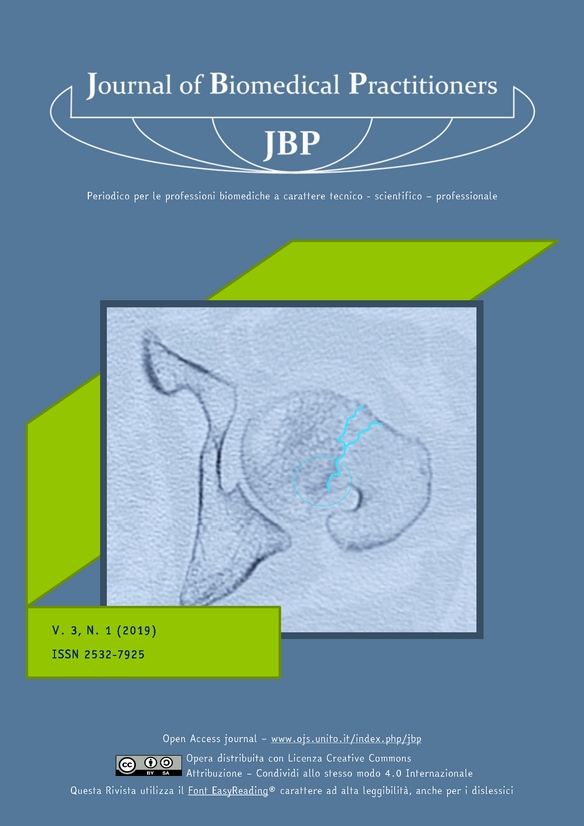Proposal for a physiotherapy treatment in patients with Femoro-Acetabular Impingement
Main Article Content
Abstract
Purpose
Femoro-Acetabular Impingement (FAI) is a common cause of hip pain, that can affect a wide range of patients. The primary purpose of this study is to propose a physiotherapy treatment based on the literature concerning patients with recent diagnosis of FAI, and evaluate his effectiveness, regarding the reduction of symptoms and the improvement of hip function. This study is connected to a recently published work1, done by a multidisciplinary team of San Marcello Pistoiese hospital, with the final aim of identifying early this condition and starting a physiotherapeutic prevention program in order to delay as much as possible the use of more invasive treatment strategies.
Materials and methods
Sixteen patients with FAI, 4 males and 12 females, met the eligibility criteria and were enrolled in the study. The treatment protocol used, based on the strengthening and stretching of hip muscles as well as improving core stability, was established following a survey conducted on studies already published in the literature. The outcome measures used to evaluate the effectiveness of the treatment were: the measurement of Passive Range of Motion (pROM) e Active Passive Range of Motion (aROM), in flexion, abduction, internal and external rotation, of the hip affected by FAI; the Numerical Rating Scale (NRS); a Patient-Reported Outcome, the Hip Outcome Score-ADL (HOS-ADL). All the previously mentioned measures were collected at the beginning of the study (T1), at the end of the planned physiotherapeutic intervention (T2) and during a 4-month follow up (T3).
Results
The analysis showed a significant reduction in pain, both between T0 and T1, and between T1 and T2 (p < 0,05). The articular range of all the movements considered, both passive and active, increased significantly (p < 0,05) at the end of treatment (T1); after 4 months (T2), a further improvement in flexion (passive and active) and in active abduction, and a reduction in internal rotation (passive and active), were statistically significant (p < 0,05). Regarding the HOS-ADL, there was a significant increase (p < 0,05) in both the primary and secondary scores at the end of treatment (T1); at the follow-up, the secondary score further increased significantly (p<0,05).
Conclusions
The physiotherapy treatment proposed was well tolerated by the patients and led to very positive results, which seems to be maintained even months after its conclusion. These results should encourage future studies on a larger sample and with a longer follow up, which could lead to more solid conclusions.
Downloads
Article Details
The authors agree to transfer the right of their publication to the Journal, simultaneously licensed under a Creative Commons License - Attribution that allows others to share the work indicating intellectual authorship and the first publication in this magazine.
References
Prioreschi T, Abdullah W, Della Sala L, Conventional radiology and CT techniques in hip impingement, guided by an applied biomechanical study. Journal of Biomedical Practitioners. 2018; 2:67-95
Amantullah DF, Antkowiak T, Pillay K, Patel J, Refaat M, Toupadakis CA, Jamali AA, Femoroacetabular Impingement: current concepts in diagnosis and treatment. Othopedics. 2015;38(3):184-99
Zhang C, Li L, Foster BB, Kopec JA, Ratzlaff C, Halai L, Cibere J, Esdaile JM, Femoroacetabular impingement and osteoarthritis of the hip. Can FamPhysician. 2015;61(12):1055-60
Thomas GER, Palmer AJR, Andrade AJ, Pollard TCB, Fary C, Singh PJ, O'Donnell J, Glyn-Jones S, Diagnosis and management of femoroacetabular impingement. Br J GenPract. 2013; 63(612): e513-e515
Imam S, Khanduja V, Current concepts in the diagnosis and management of femoroacetabular impingement. IntOrthop. 2011;35(10):1427-35
Kisner C, Colby LA, Esercizio terapeutico, Terza edizione italiana, Padova, Piccin, 2014
Griffin DR, Dickenson EJ, O'Donnel J et al, The Warwick Agreement on femoroacetabular impingement syndrome (FAI syndrome): an international consensus statemant. Br J Sports Med. 2016; 50:1169-1176
Wall PD, Fernandez M, Griffin DR, Foster NE, Non operative Treatment for Femoroacetabular Impingement: A Systematic Review of the Literature. PM R. 2013;5(5):418-26
Wright AA, Hegedus EJ, Taylor JB et al, Non-operative management of femoroacetabular impingement: A prospective, randomized controlled clinical trial pilot study. J Sci Med Sport. 2016;19(9):716-21
Wall PD, Dickenson EJ, Robinson D et al, Personalised Hip Therapy: development of a non-operative protocol to treatfemoroacetabular impingement syndrome in the FASHIoN randomized controlled trial. Br J Sports Med. 2016;50(19):1217-23
Aoyama M, Ohnishi Y, Utsunomiya H et al, Randomised, Controlled Trial Comparing Conservative Treatment With Trunk Stabilization Exercise to Standard Hip Muscle Exercise for Treating Femoroacetabular Impingement: A Pilot Study. Clin J Sport Med. 2017; 0:1-9
Pun S, Kumar D, Lane NE, Femoroacetabular impingement. ArthritisRheumatol. 2015;67(1):17-27
Fernandez M, Wall P, O'Donnell J, Griffin D, Hip pain in young adults. AustFamPhysician. 2014;43(4):205-9
Lodhia P, Slobogean GP, Noonan VK, Gilbart MK, Patient-reported outcome instruments for femoroacetabular impingement and hip labralpathology: a systematic review of the clinimetric evidence. Arthroscopy. 2011;27(2):279-86
Casartelli NC, Maffiuletti NA, Bizzini M, Kelly BT, Naal FD, Leuning M, The management of symptomatic femoroacetabular impingement: whatis the rational for non-surgical treatment? Br J Sports Med. 2016;50(9):511-2
Hunt D, Prather H, Harris Hayes M, Clohisy JC, Clinicaloutcomesanalysis of conservative and surgical treatment of patients with clinical indications of prearthritic, intra-articular hip disorders. PM R. 2012;4(7):479-87
Emara K, Samir W, Motasemel H, Ghafar KA, Conservative treatment for mild Femoro-Acetabular Impingement. J OrthopSurg (Hong Kong). 2011;19(1):41-5

